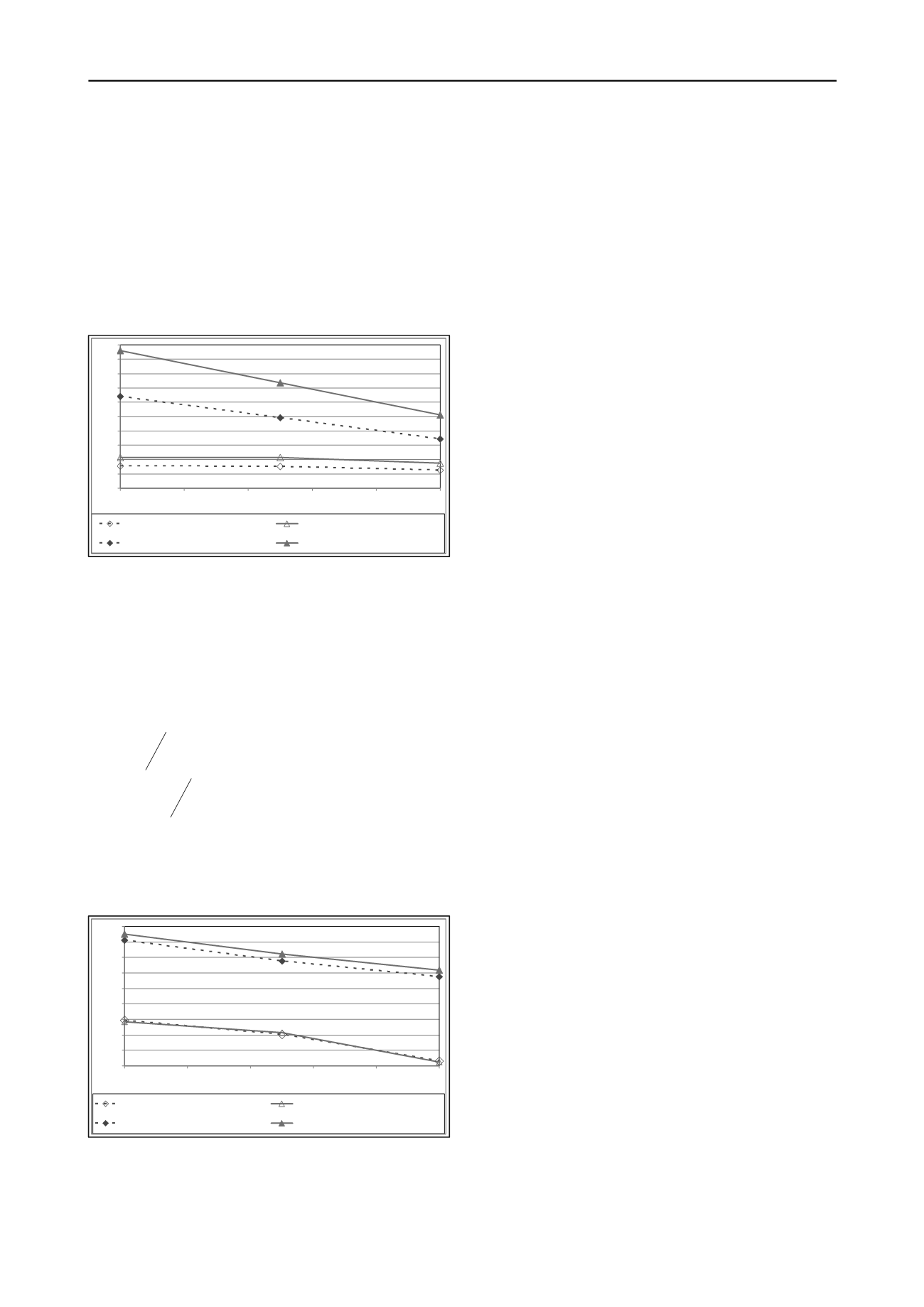
2552
Proceedings of the 18
th
International Conference on Soil Mechanics and Geotechnical Engineering, Paris 2013
the maximum allowable axial stresses in soil-cement
columns defined by the Ucs value and verified by the fem
analysis was not exceeded for different cases of grid spacing,
surcharge and column lengths taken into consideration in the
project.
the comparative study of the maximum vertical
displacement, in cases without and with the soil improvement
for different grid meshes is shown in figure 7. the significant
settlement reduction with the applied soil improvement can be
observed in function of grid spacing and for different
thicknesses of the soft soil layer.
figure 7. maximum vertical displacements.
the numerical calculations were also analyzed in terms of
load and settlement efficiency (asiri 2012) in order to
determine the effectiveness of the soil improvement method.
the load efficiency (e
l
) is defined as a ratio of a transmitted
load to the head of a soil-cement column and the total load
acting on the unit cell. the settlement efficiency (e
set
)
represents the reduction of a settlement by a soil-cement column
compared to the settlement of the unit grid without ground
improvement. they are represented by the following equations:
QW
QE
P
L
(2)
0
1
S
S E
M
set
(3)
where: Q
p
is the load acting on the head of soil-cement
column, W is the dead load of the load transfer platform and Q
is the force of the surcharge applied to the slab. s
m
is the
settlement of the soil reinforced by soil-cement columns
measured at the surface of the load transfer platform and s
0
is
the settlement of the natural soil without ground improvement.
figure 8. load and settlement efficiency.
the results of the load and settlement efficiency are given in
figure 8 in terms of different grids adopted in the project for
different surcharge loads and for different column length in
function of the thickness of the soft layer. Both terms of
efficiency have the same tendency. the load efficiency ranges
from 36 to 50 %, while the settlement efficiency varies between
64 and 78 %. the difference of approximately 25 to 30 %
between load and settlement efficacy relationships is observed.
it is important to emphasize that the estimated settlements
obtained by the analysis by fem were in accordance with the
observed settlements after ground improvement by the
performance of soil-cement columns and re-loading of the slab
of the industrial building.
6 conclUsions
the general application of the wet deep mixing method by the
springsol
system for ground improvement of existing paving,
embankments and subbase below railways and roads, and
underpinning of existing structures is presented. the case
history of underpinning of existing industrial building, which
settled due to poorly compacted antrophic fill, with the use of
the springsol
system is reported.
0
5
10
15
20
25
30
35
40
45
50
1,5
1,6
1,7
1,8
1,9
2
Grid spacing (m)
Settlements (cm)
With improvement SC col length 5.5m
With improvement SC col length 8m
Without improvement thickness 5.5m
Without improvement thickness 8m
1
2
4
3
3
4
1
2
the design procedure and the estimation of settlements by
the finite element method (plaxis commercial code) based on
axisymmetric model is in concordance with the monitored
settlements. the general homogenized nature of settlements, as
well as insignificant differential settlements are achieved by the
good interaction of the performed soil-cement column and load
transfer layer formed by grouting of the layer of gravel below
the slab. the evaluation of efficiency of the soil treatment by
soil-cement columns, in terms of load and stress efficiency, is
determined confirming its effectiveness.
7 acKnoWledGements
the authors wish to thank to the personnel of Grupo rodio-
Kronsa for their technical assistance, especially to Juan ignacio
lópez, Juan manuel dimas, francisco martín and esteban
casado. also, the collaboration and provision of all necessary
information by the proprietary of the industrial building is
highly appreciated.
8 references
asiri national project 2012. recommendations for the design,
construction and control of rigid inclusion ground improvements.
Bruce d.a. 2001. an introduction to deep mixing methods as used in
geotechnical applications, Volume iii: the verification and
properties of treated ground. U.s. department of transportation,
federal highway administration, report fhWa rd-99-167.
cdit (coastal development institute of technology), Japan. 2002. the
deep mixing method, a.a. Balkema.
innotrack. project nº tip5-ct-2006-031415. 2009 subgrade
reinforceemnt with columns. part 1 Vertical columns, part 2
inclined columns.
35
40
45
50
55
60
65
70
75
80
1,5
1,6
1,7
1,8
1,9
2
Grid spacing (m)
Efficiency (%)
Load efficiency - SC col length 5.5m
Load efficiency - SC col length 8m
Settlement efficiency - SC col length 5.5m Settlement efficiency - SC col length 8m
1
2
3
4
1
2
4
3
le Kouby a., Bourgeois e. & rocher-lacoste f. 2010. subgrade
improvement method for existing railway lines – an
experimental and numerical study.
EJGE
Vol. 15: 461-494
melentijevic s., martin f. & prieto l. 2013. execution of springsol
deep mixed columns: field trials.
International Conference
Installation Effects in Geotechnical Engineering. Rotterdam. The
Netherlands. 24-27 March 2013
: accepted for publishing.
melentijevic s., prieto l. & arcos J.l. 2012. aplicaciones de columnas
suelo-cemento tipo springsol
.
9º Simposio Nacional de Ingenieria
Geotécnica. Cimentaciones y Excavaciones Profundas. Proc. Symp.
Sevilla. 17-19 October 2012
: 255-268.
plaxis BV. 2008. plaxis 2d manual - version 8.
.


